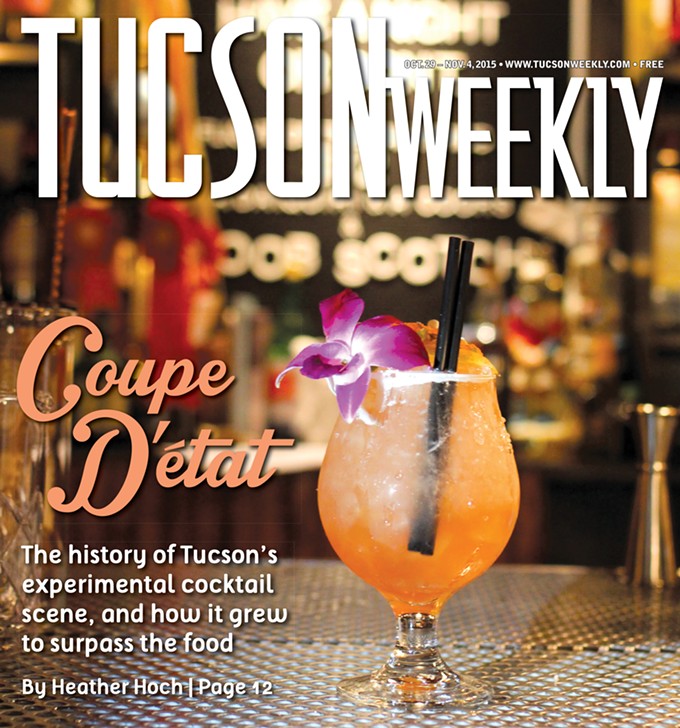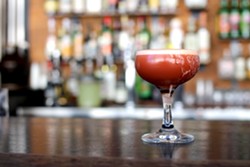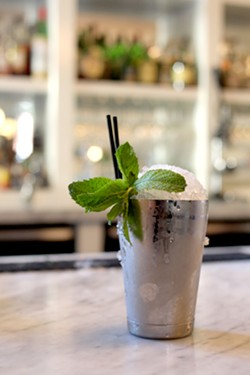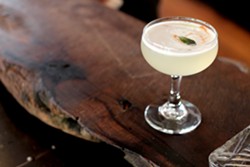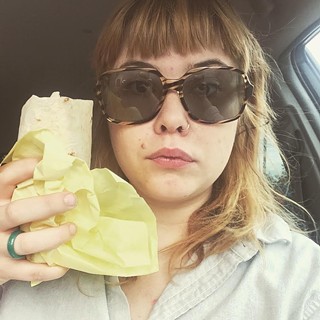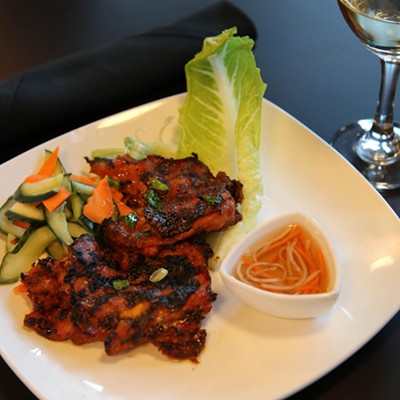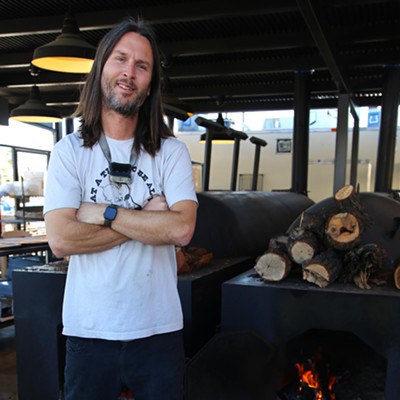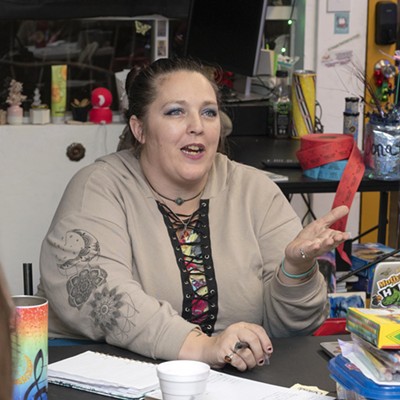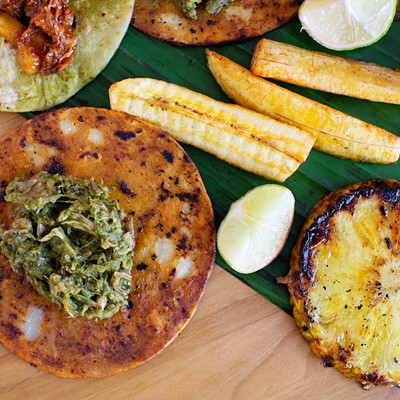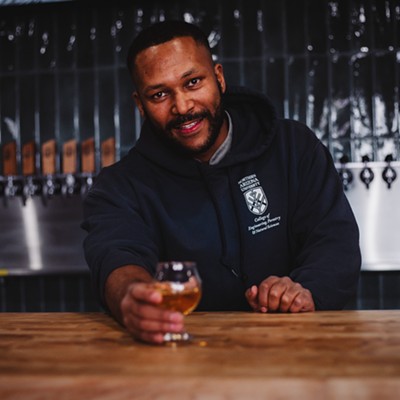It was a dimly lit red room. Through the saloon doors in the back of The Grill, you'd find some nights the record player atop the photo booth would play The Raincoats as barflies sipped esoteric wines and spirits priced well below the norm. (A shot of Pappy Van Winkle 20 year was $9, now that same shot runs closer to $30.) Other nights, raucous live and local music would see guests crowd surfing to the bar for a $3 shot of whiskey or a $1 can of High Lifes.
"We were serving the downtown Tucson population—the freaks and bums and artists and goth kids," Wilko bartender Luke Anable says of his first bar job. "At some point your friends might come in and at some point 3 a.m. comes around and you'd get to go home."
Anable filled the Red Room with thrifted glassware and completely changed the back bar, expanding from a single English pub ale to a stock of sour beers, high-end liquor and more, the likes of which Tucson hadn't really seen before. Back then, it was all one big experiment or, as Anable puts it, a movement that flourished on "low stakes and big feelings."
"We had no models for cocktails back then. We didn't even use sugar in our drinks, which in retrospect pretty much means that our cocktails were horrible." He says they'd occasionally micro-grate piloncillo block sugar on top of a cocktail. "It was a joke."
"There wasn't a sense that some things were cooler than others. There were way less trends," he says.
From 2008 when Anable started to 2010, The Grill's "ratty little dive bar" had grown to have 40 bottles on hand with a selection of old world wines as well. Anable had changed everything from the lighting to the sound system.
"It was easy to feel a sense of ownership there.
"Everything revolved around that place. The owner Patrick Forsythe has this punk-rock ethos and anyone confronted with it would want to be drawn to it," he says, "There was really nowhere else to be drawn to."
By 2011, The Grill and therefore the Red Room had completely run out of money. Anable says they paid the last week's beer stock largely out of pocket.
"The last six months sucked for everyone," he says. "Things were left falling apart, no one was paid ... there's no reason to dust it with a romantic narrative ... when it closed it needed to close."
One bartender in town describes the night The Grill closed as such:
"Patrick grabbed a bottle off the bar, lit a cigarette—which was a big deal because he had been one of the last holdouts in town to observe the recent smoking ban—and all hell broke loose." They knew it was the end of a cultural era that included drinking as much as it did music and art.
A little over a year later and just after 3 a.m., the building that once housed the popular watering hole—one of the epicenter's of Tucson's cocktail birth—set fire and the building it once lived in was irreparably damaged. No one is condoning arson, but for a tight-knit community driven with passion and little rules, it makes sense. After all, it had existed with that same "punk-rock ethos" for years and, as the prickly chaparral has adapted to propagate after wildfires, maybe that spot just simply couldn't continue to exist anymore in order for the scene to grow overall.
When 47 Scott opened in October 2010—five years ago almost exactly to this day—the scene began to refine.
THE WEISE GUYS
Many of Tucson's top bartenders are quick to point to Ciaran Weise as the godfather of the city's craft cocktail movement. Although he had technically begun behind the bar at the now defunct Barrio Food & Drink, his real training came from a previous stint of serving in the midst of the already exploding New York City cocktail scene. Weise considered becoming a chef at first, but was drawn to the guest interaction that you get behind the bar.
"Doc [Aaron Defeo] was the only person really doing anything with [cocktails] when I moved back," Weise explains.
Defeo had instituted a then-revolutionary fresh juice program behind the bar at Hotel Congress, and things were changing. While Anable and his co-workers focused on learning all they could about the spirits themselves, Weise pulled from a wealth of knowledge of cocktail recipes to train other bartenders and create balanced concoctions of his own. However, he admits his step into the cocktail world was more of a stumble—a lucky promotion after Barrio's two bartenders quit.
"I'm lucky to have had the opportunity to do that," Weise says. "I don't know that I'd have had that opportunity if those two bartenders didn't quit."
When he took a consulting position five years ago for 47 Scott just before it opened, everything changed for Tucson cocktails.
"Ciaran knew cocktails could be a concept in a way that never really struck us. He knows how to meld flavors ... he really has a gift for it," Anable says. "If Red Room closing was the moment that iteration of downtown ended, then Scott & Co. was the moment Tucson cocktails grew up."
With (then) Hotel Congress' Mike McGill and a unknown kid named Karl Goranowski opening, 47 Scott quickly gained recognition. It adopted the landlord's office space next door, opened a coffee shop by day, cocktail bar by night outpost called Scott & Co. and the accolades came pouring in from local and national media alike.
"All of the sudden the celebrity bartending culture exploded—I'm not into that part of it," Weise says.
After working with and training some of Tucson's top talent behind the stick, including Goranowski, McGill, Tough Luck Club's Niklas Morris, Tap & Bottle's Connor Mansager and more, Weise moved to Portland. However, his willingness to train left an indelible mark on the city.
"It comes down to the individual. I was so into bartending that I was happy to talk to anyone about it," he says.
But, of course, with any tertiary market, no matter how genuine the passion, greener (yes, in terms of money as much as experience) pastures await. "If anybody is good, they tend to move away," Weise says. Such is true of Weise, Mansager, Will Elliott (who worked with Anable at the Red Room and is now is known for his outstanding work at NYC's Maison Premiere), Fransisco Terrazas (who headed the award winning mezcal-centric program at Houston's Pastry War) and more.
Luckily though, that wasn't the last Tucson would see of Weise.
EXPAND AND CONTRACT
Karl Goranowski was working at the front desk at Hotel Congress, and he was desperate for a new gig. One day, he spent the last money he had on $3 you-call-its after work to hang out with Weise. It worked, and Weise offered Goranowski a job at 47 Scott and the rest is history ... well, not quite.
Goranowski points to a few reasons for a history major, political science minor to get into bartending. Deep in the quagmire of a crushing recession when "jobs were shed by the thousands," bartending was a way to make a name and some money for himself.
"Creative and talented people saw the bar as a way to make a living and be social still," he says, "we didn't have anywhere else to go."
Behind the bar, he found a haven to create without having to go back to school and accrue more debt.
"Bartending is easy to care about. You make more than the median income in this city, there's a camaraderie that the job includes," he says. "It's a job that entails what most people do for leisure. You don't need to go to school to be a bartender, you just show up and do it."
Training under Weise at Scott & Co. allowed Goranowski the time to dive into the culture and history of cocktails.
"I think I read 45 cocktail books in my first year," he says, "but it was also about playing with ingredients and tasting, tasting, tasting."
Once 47 Scott's sister restaurant, Saint House, opened, Goranowski found himself heading the program and diving into a rum-focused bar concept.
Similarly, Bryan Eichhorst was a brunch-time bartender (for those unfamiliar with bartending hierarchy, that's not the ideal shift) at Maynards when Weise came in. Eichhorst, who was a UA dropout from the English program that had just returned from New York, made Weise an "obscure classic" and was also offered a job.
"I moved away in a grey flannel suit," he says. "I came back looking for a 'rambling man job' and this is pretty much the go-to English major job because you get to use trivial knowledge and it pays well. Plus, all the bartenders were the cool kids."
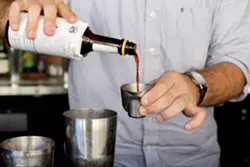
In the next couple years, Tucson's cocktail scene slowly spread across the city into spaces like Nox Kitchen, Umi Star, Sidecar, Penca, R Bar, Agustin Kitchen and even a couple not so on-the-books DIY bars. Talent popped up, some of it moved on, but a decent majority of it stayed in town.
"You look at Scott and pretty much anyone who's come out of there is running their own program now," Eichhorst says. "It set the standard. Like, now if you don't meet the Scott & Co. standard at minimum, you're pretty much worthless."
Meeting that standard isn't enough, though. Just as some of the talent behind the bar moved on, restaurants like Nox, Umi Star, Saint House and more have all folded in the scene, despite having decent cocktail programs at the time. Goranowski found himself running two bars to being unemployed the next. The wild, rebellious spirit that influenced the scene that came out of the Red Room paired with the intricate focus on execution and flavor that Weise nurtured at Scott & Co., and all of that embellished by self-taught outliers like Defeo, Morris and Drew Record (formerly Playground and Pasco), created a bar culture in Tucson that's quite unique.
"Tucson has always had a great drinking culture because it is a blue-collar town," Goranowski explains. "Going to bars is engrained in peoples' lives here."
On top of that, bartenders in Tucson are bartenders. They're happy to suggest, share knowledge or tell a story without the unnecessary airs of pretension that sully bigger cities. If you want to learn, you pull up a chair and listen. The drinks are executed with a mind for precision and consistency, knowledge of the classics and the balance they achieve and an innovative, rule-breaking edge that creates one-of-a-kind cocktails—plus it doesn't hurt that they're a few bucks cheaper than the ones you'll find in larger markets.
DON'T HOLD BACK
Now with those fuzzy feelings in tact, there's some bad news. Although Tucson's cocktail scene has developed into a robust and forward-thinking movement headed by bars like Tough Luck Club (which offers an impressive zine-style menu with over 20 cocktails that change four times per year), Agustin Kitchen, Penca, Wilko and more, it's no secret that people behind the bar and in the kitchen feel the food in this town has some catching up to do.
"When you look at it, everyone here is even setting the table the same way," Weise says.
For instance, for a food community that houses some of the most progressive initiatives to maintain native vegetables, fruits, grains and more through the Native SEEDS/Search and the Mission Garden, those Sonoran heritage foods are used sparingly, if ever—even in establishments that claim to be hyper-local.
"If you look at the number of places that can make a good cocktail in this city, it's staggering," Goranowski says. "There are 10 or 11 bars you can walk into and get a great cocktail—the culinary scene needs to achieve the same level."
No one is claiming kitchen staff aren't some of the most hardworking folks in town, but the issue of retention and growth lies in pay, training and burn out.
"Money-wise, food service is undervalued. There's almost no infrastructure here for education, no one in the kitchen is paid well, mentorship in the kitchen is lacking overall," Eichhorst explains. "People have to demand it."
Every person quoted in this article was quick to point to the long hours, low pay and demanding conditions in the kitchen. That's not to say bartenders aren't subject to the same issues, but the benefits of interaction in the much more soothing (and less hot) front of house environment and supplemental tips can counterbalance the negative aspects.
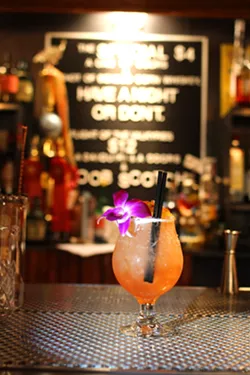
"Out of all of my old shitty scumbag hipster friends, half went to the kitchen and half went to the bar. It really isn't a different type of person," Eichhorst says.
Goranowski also agrees that formal training and education are an issue.
"The average line cook in Portland has been to culinary school, but here its typically people who have started as a dishwasher," he says. "Then, as soon as someone is good enough to be promoted to a managing role, they aren't in the kitchen anymore."
Tyler Fenton, owner of both Reilly and Tough Luck Club and chef of the restaurant, says he's tried to combat the service industry wear down and high turnover by investing in his employees. To him, this means training and mentorship as much as it does more concrete solutions like raising all wages by a few dollars per hour and offering benefits to full-time employees, regardless of their position. After all, if you want professional serving staff, kitchen crew and bartenders, you do have to treat them as such, or at least offer enough incentive so it's not a "whatever job," as Fenton puts it.
However, even with those measures, Fenton says raising food up is still not an easy task.
"Getting people to be adventurous in either department is a leap," Fenton says. "Behind the bar, you can direct the conversation with the person who knows the most about it. You don't get that in a restaurant unless you open a weird 10-seat tasting kitchen."
Even with a highly experimental, upscale, high-concept restaurant, you can run into roadblocks.
"People have a lot of food phobias," Fenton explains. "It's easy to play the hits, but it's about having the confidence and talent in the kitchen. You need a depth of committed people."
Eichhorst agrees, "Cocktails aren't as intrinsically linked to nostalgia. Experimentation with food gets nipped in the bud pretty quickly."
One way Agustin Kitchen's former chef Ryan Clark worked to brave new territory without intimidating customers was with new specials. He says most of his dishes on the regular menu had to be priced around or under $20 to sell, which vastly limits the use of certain quality ingredients, but, on a special, he could use those high-dollar ingredients and price the dish over $30. Still, factoring in general overhead, specialty sourcing and calculating a fair wage for all staff into the equation, all while being experimental, is near impossible.
"It hinders the food scene when people won't pay for it," Clark says. "Tucson is definitely a drinking culture, and people are willing to spend money on it for sure."
"If I want to put a pork belly dish on the menu, I'm probably spending $1,000 on [research and development] alone," Fenton adds.
While Fenton looks to restaurant menu collaborations and dinner events to help build camaraderie in the restaurant scene the same way as the bar community has managed to, Luke Anable wonders if Tucson even really needs to build a more experimental culinary culture.
"Culinary food culture doesn't start with innovation. It starts with good ingredients being prepared well and consistently, and before it just wasn't being done well here," he says. "Really innovative culinary culture isn't important to the culture of a city."
Anable points to the chef at Wilko, Ian Sugarman, as a source of inspiration, but also the bread program at Time Market and the quality, simplicity and execution at 5 Points Market. To him, a place where you can buy a loaf of quality artisan bread is more important for the everyday food culture of a city than those fancy tasting menus.
Still, with even mid-level restaurants closing, it's a wonder if Tucson can sustain a dining culture in the way it has with cocktails.
"There've been so many failed concepts that didn't deliver. People become cynical, but I'm hopeful. I see it happening," Anable says. "I think these things are there, you just have to look for them."
SHAKE IT UP
Even with the more supportive cocktail culture, things are in flux behind the bar in Tucson. While Weise and Eichhorst plan to stay put for the time being, Anable is turning over Wilko's cocktail menu to bartender Sara Roche so he can focus on a new gig consulting for Good Oak Bar. There, he plans to institute an expanded wine selection, more local beer, a completely new agave and American grain distillate program and a "transparent" cocktail menu to complement.
Goranowski, on the other hand, is stepping out of the Tough Luck Club basement bar, packing up and moving to San Francisco to work at Aatxe. There's no doubt that losing someone who started five years ago at Tucson's first real cocktail bar and has run and been a part of some of the town's best bars since is a hit to Tucson cocktails, but Anable points to Eichhorst, Roche and more as the new guard of Old Pueblo cocktailing.
"They're doing their own thing. I don't know where it leads us, but it'll definitely take us in a different direction," he says.
However, the bar scene isn't without its own issues amidst growing popularity.
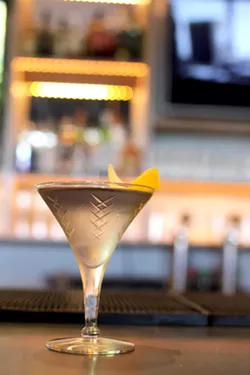
"We need to get back to a more healthy and organic scene, which means being free to make up your mind based on what's in front of you and not buying into the hype mixology gimmick," he says, adding a warning of the ever-present threat in trying to be the best or top something. "The danger of modern mixology is for everything to be a superlative. What you lose is a sense of things being contextual. That's why we memorize 100 cocktails—so we can provide the right thing at the right time."
That "superlative" mentality tends to lead to a focus that goes past being a good bartender who makes balanced drinks and, instead, takes the scene into a mindset that things have to be weird to get attention.
"Innovation for innovation's sake is unsustainable. Everything is borrowed," Anable says. "When you start to think you're more important than you are, it begins to erode your sense of belonging in your own bar."
Weise points to another issue in Tucson's tight knit cocktail bartending community: the lack of women behind the bar.
"I don't understand it. Some of the hardest working bartenders I've ever met are women, partially due to the fact that they've always kind of had to work harder to prove themselves," Weise says.
As Goranowski sees it, with more inclusion overall, the culture will grow in a more sustainable way.
"When the people that care keep caring and new people start caring, it democratizes the scene," he says.
Eichhorst sees Tucson's cocktail community growing in other ways too. For him, maybe it means new bars outside of downtown or ones that offer niche experiences, be it a dedicated whiskey bar, a true Tiki bar, a loud, high-volume bar or an upscale lounge. At Penca, Eichhorst has the opportunity to focus his program with a 30-plus bottle mezcal selection, house-made tepache and a sangria program.
Over at one of Tucson's newest dining additions, OBON Sushi Bar Ramen, bartender Matt Martinez explores the world of sake, Japanese whiskey, soju and more to pair with the restaurant's fare. Martinez began as a dishwasher then prepped as a "sushi bitch" then was promoted to be a sushi chef and then wound up bartending at Nox and Scott & Co.
"I grew from watching people that really gave a shit about what they were doing, but you could also blaze your own trail," Martinez says. "I felt back of the house experience could benefit the scene because it's where I learned structure."
However, even he admits he's a little surprised the cocktail scene has sustained itself this long.
"For a while I thought we'd swing back to the beer and a shot thing, but the culture doesn't seem to be slowing down," he says. "Now it's about learning to move volume without it being cumbersome. Everyone should have a cocktail list that they're proud of, but I think pretentious cocktails are a thing of the past."
In the U.S.'s 33rd largest city, it's refreshing to find drinks and bars that can be put up to the big guys, you know, without the wait. And, though he's leaving, Goranowski probably puts it best when he says:
"Would I take any cocktail in this city up against any other city? Absolutely."
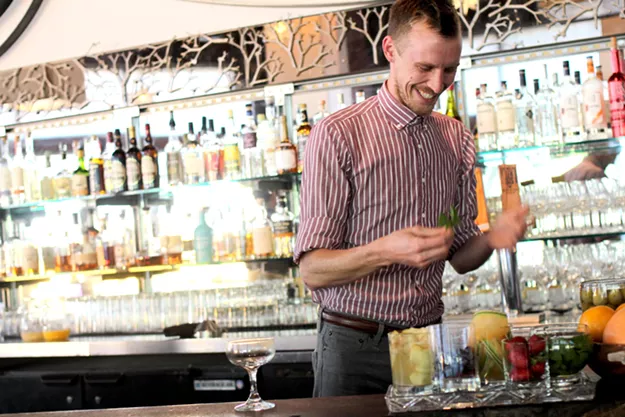
Luke Anable of Wilko
First Bar Job: Red Room
Favorite Bar in Tucson: R Bar. I worked with Rory [O'Rear] and our tastes grew up together.
Favorite Cocktail Ingredient Right Now: Either local mesquite syrup because it's mellow and fragile or burnt sugar syrup. I love it, but it's disgusting and I don't know what to do with it yet.
Favorite Cocktail to Drink: It's seasonal, but any cocktail from a good bartender because I love tasting new things. In general, a Manhattan on the rocks or a Vieux Carré.
Favorite Cocktail to Make:
Owen Wade (named for R Bar's Matt Wade)
2 ounces buttermilk washed pisco
½ ounce Chinati Vergano blanc vermouth
½ ounce vanilla bean tea
¾ ounce lime juice
Shake hard, fine strain into a coupe, sweep with Angostura.
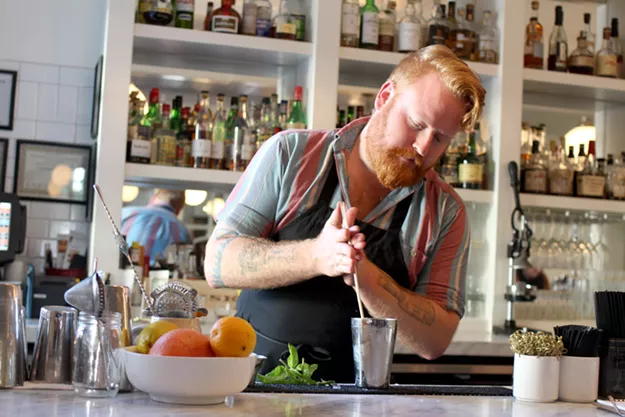
Ciaran Wiese of Agustin Kitchen
First Bar Job: Barrio Food & Drink
Favorite Bar in Tucson: R Bar
Favorite Cocktail Ingredient Right Now: Suze—it's bright but still has a bitter gentian edge.
Favorite Cocktail to Drink: Sazerac in the winter or a daiquiri in the summer.
Favorite Cocktail to Make:
Mint Julep
2 ounces bonded bourbon
½ ounce rich demerera simple syrup
Press mint leaves with a spoon in the mixture, swizzle with crushed ice, add more crushed ice until you can form a cone over top, garnish with a bouquet mint leaves.
Karl Goranowski of Tough Luck Club
First Bar Job: 47 Scott
Favorite Bar in Tucson: The bar I spend the most money in is probably R Bar.
Favorite Cocktail Ingredient Right Now: Aromatic bitters like Angostura, Peychaud's or Abbott's
Favorite Cocktail to Drink: It depends on the context. Usually I just go for champagne or it could be a cheap beer after work.
Favorite Cocktail to Make:
Crossfire Hurricane
1 ounce cachaça
¾ ounce sloe gin
¾ ounce velvet falernum
¾ ounce lime juice
2 dashes tiki bitters
Serve in a pilsner glass over crushed ice with a lime wheel, edible flowers, an umbrella and two straws as garnish.
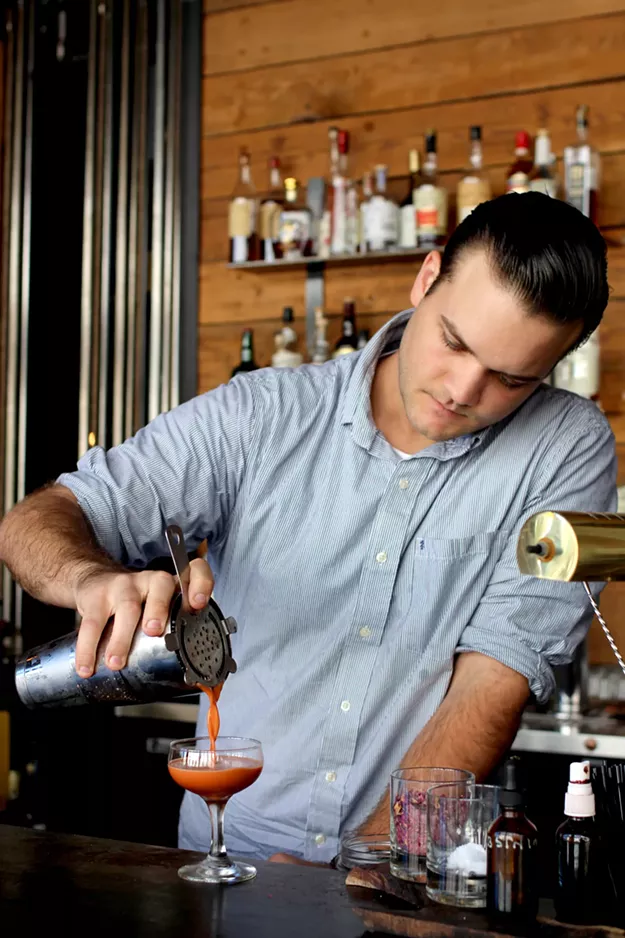
Bryan Eichhorst of Penca
First Bar Job: Friedman's Deli, technically, but also Maynards
Favorite Bar in Tucson: Che's Lounge is where I feel most comfortable to sit down and have a drink.
Favorite Cocktail Ingredient Right Now: I'm excited about fermented anything. It's the basis of our entire profession and the backroom of Penca is full of experiments.
Favorite Cocktail to Drink: Probably a Manhattan. It's simple, easy and concise.
Favorite Cocktail to Make:
Angostura Sour
2 ounces Angostura
¾ ounce lime juice
½ ounce simple syrup
1 egg white
Shake non-alcoholic ingredients together vigorously, then add Angostura and ice and shake again, serve up in a coupe.
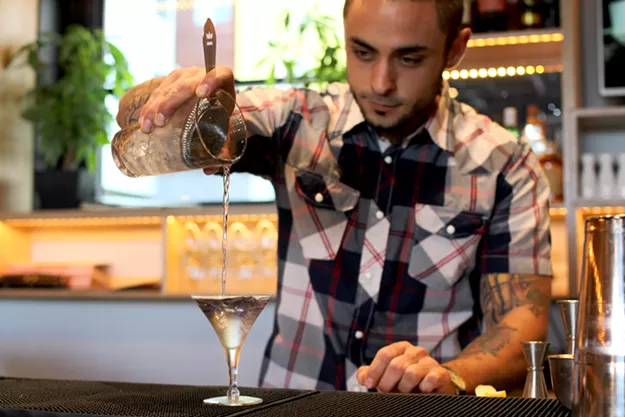
Matt Martinez of OBON Sushi Bar Ramen
First Bar Job: Nox
Favorite Bar in Tucson: Unplugged if I'm in downtown or Kingfisher
Favorite Cocktail Ingredient Right Now: Amaretto, but I'm jazzed on bitter almond flavor in general.
Favorite Cocktail to Drink: Boulevardier—it's simple, but abrasive on the palate. It's a more rich version of the Negroni.
Favorite Cocktail to Make:
Arsenic and Old Lace
2 ounces gin
¾ ounce dry vermouth
¼ ounce crème de violette
Rinse your coupe with absinthe, pour the stirred cocktail, express lemon zest over cocktail and serve.

